Shopify vs Amazon Showdown: Which Platform Leads in 2024?
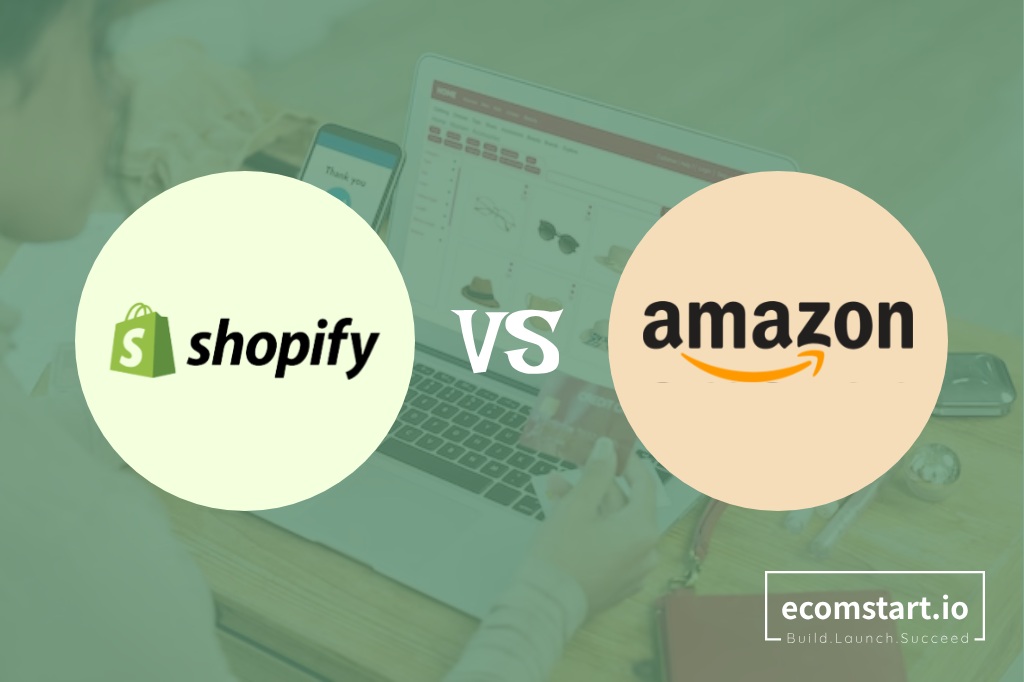
Choosing the right eCommerce platform can be a game changer for your online business. In that context, Shopify vs Amazon emerged as the two leading platforms and are always the top concerns of many entrepreneurs. Each platform offers unique benefits, meeting different business models and seller needs.
Specifically, Shopify offers a customizable online store and allows you to control your brand and customer experience fully. On the other hand, Amazon offers a larger marketplace with a built-in customer base.
In this comparison, eComStart will analyze the key features, costs, apps and tools, and other criteria of Shopify and Amazon, which will help you decide which platform is the best for your business.
Whether you’re launching a new online store or looking to expand your existing sales channels, understanding the difference between Shopify and Amazon is vital to your success in this digital marketplace.
1. Key differences at a glance: Shopify vs Amazon
| Shopify | Amazon | |
| Definition | – An all-in-one eCommerce platform – Allows users to create, design, customize, and manage their own online stores. | – A global online marketplace that connects sellers with customers globally – Focuses on selling rather than store customization. |
| Rating | Highly rated, 4.5/5 on average of 6.2k reviews on GetApp. | Highly rated for its massive audience reach and ease of selling. |
| Pricing | Start for free, then $1/month for first months, after that: – Basic: $39/mo – Shopify: $105/mo – Advanced: $399/mo (For monthly billing, 25% off for yearly billing) | – Individual plan: no subscription fee but $0.99 per item sold – Professional plan: $39.99/month |
| Target Audience | Individuals and businesses looking to create an online store with complete design, functionality, and branding control. | Sellers looking to tap into a large market without a standalone website. |
| Design & Customization | Highly customizable, with access to various themes and an advanced website builder. | Limited, as the focus is on product listings rather than store design. |
| Ease of Use | Intuitive interface and straightforward setup process. | Easy to list products and start selling with minimal setup, but competitive. |
| eCommerce Features | Robust with features like inventory management, payment processing, and analytics. | Powerful with fulfillment by Amazon, customer service, and global marketplace access. |
| Marketing Tools | Offers built-in SEO features, email marketing tools, and social media integration. | Limited compared to Shopify, primarily through sponsored product ads and basic SEO for listings. |
| Apps & Integrations | Extensive app marketplace with over 8,000 apps and integrations for enhanced functionality. | Limited to Amazon’s services and integrations, focusing on selling tools rather than website functionality. |
| Scalability | Easily scales with your business, suitable for small to large enterprises. | Massive, designed to accommodate sellers of any size with access to a global audience. |
| Pros | Full customization, extensive app marketplace, and strong support. | Access to a vast customer base and fulfillment services by Amazon. |
| Cons | – Monthly fees can add up – Requires time to master customization. | – High competition, fees can be significant – Limited branding opportunities. |
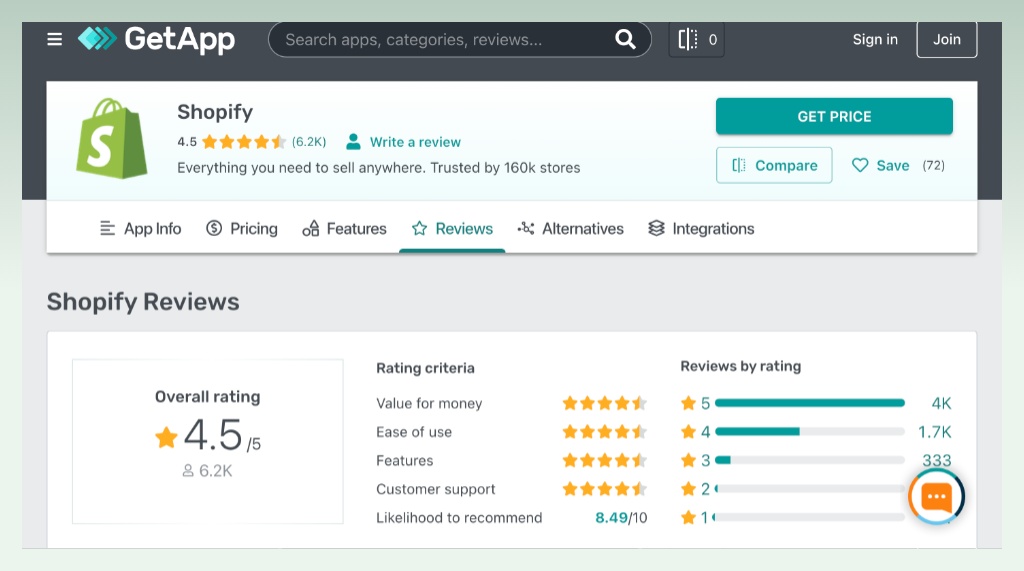
Shopify is a comprehensive eCommerce platform that enables you to set up, operate, and scale your businesses online, in-store, or anywhere. This platform provides you with extensive online sales, marketing, and management tools.

Amazon, on the other hand, is a global marketplace connecting sellers to a vast audience globally. It reaches a broader customer base and provides ease of selling over customization. This platform is suitable for sellers looking to access a large market quickly without the need to build a website. However, it limits branding and can incur significant fees in a competitive environment.
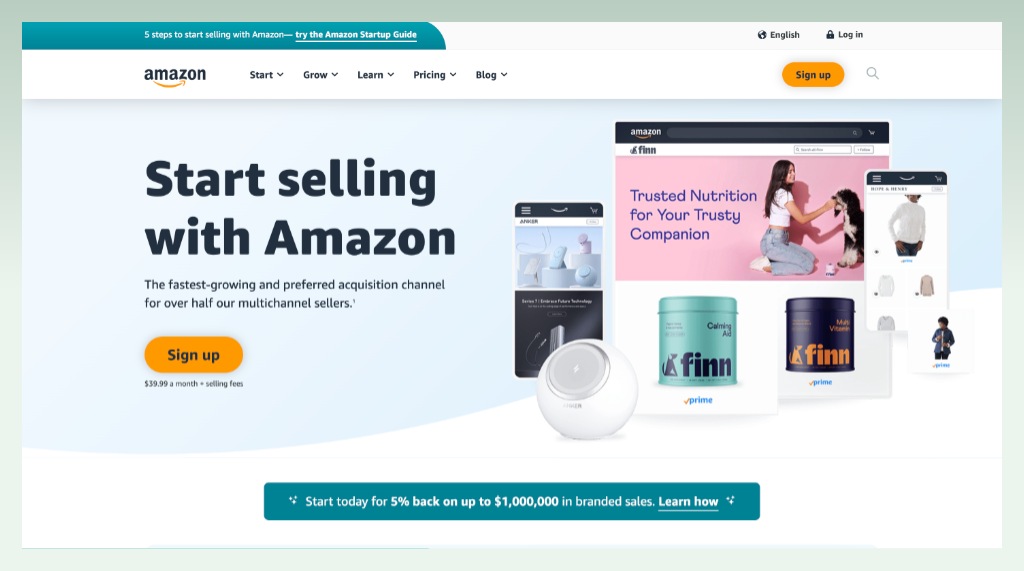
The key difference between Shopify and Amazon is their focus: Shopify on customized online store creation and seller control, and Amazon on easy market access with less customization. Your choice depends on whether you value creative control and branding (Shopify) or broader audience reach with less branding focus (Amazon).
💡 Learn more: Shopify vs Etsy: Which is Best for Startups?
2. Shopify vs Amazon: A Deep Dive Comparison
2.1. Pricing
| Pricing Criteria | Shopify | Amazon | |
Monthly Bill | – Basic: $39/mo – Shopify: $105/mo – Advanced: $399/mo (For monthly billing, 25% off for yearly billing) | – Professional plan: $39.99/month + referral fees based on product category. – Individual plan: no monthly fee but $0.99 per item sold + referral fees based on product category. | |
| Transaction Fees | – None if using Shopify Payments – Vary by plan if using third-party payment gateways: + 2% for Basic Plan + 1% for Shopify Plan + 0.5% for Advanced Plan | Additional referral fees on sold items typically range from 6% to 45% of the product’s selling price, products on the category, with a median of around 15%. | |
| Additional Fees | – Fees for using payment providers other than Shopify Payments vary – Additional costs for apps and themes. | – Fulfillment by Amazon (FBA) fees for storage and fulfillment if using Amazon’s fulfillment services – Other potential costs: closing fees, rental book service fees, high-volume listing fees, and refund administration fees. | |
| Basic Cost of An Online Store | – Basic plan with free theme: $39 per month – Basic plan with paid theme: $119 per month | – Solopreneur with FBM and Individual Plan: $50-$150/month – Small business with FBA and Professional Plan: $200-$500/month – Established seller with FBA and extensive marketing: $500-$1000+/month | |
Shopify pricing

Amazon pricing
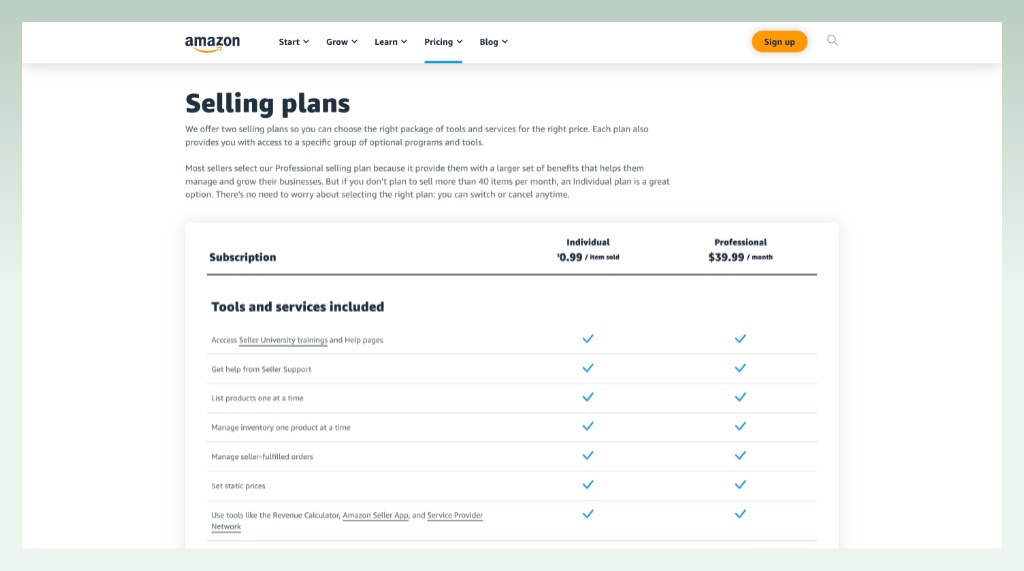
In general, Shopify offers transparent monthly plans, enabling you to easily calculate your budget, but it charges transaction fees. On the other hand, Amazon has a lower upfront cost with its Individual plan, but variable per-item and fulfillment fees can complicate budgeting.
Thus, for low-volume sellers, Shopify’s Basic plan might be cheaper. For high-volume sellers, Amazon’s Professional plan could be more affordable.
Our verdict: Shopify wins for transparent pricing and brand control, while Amazon shines for its low cost in case of high-volume sales.
2.2. Design & customization
| Criteria | Shopify | Amazon |
| Template Variety | About 180 themes, with 12 free options. | Limited templates primarily for product listings. |
| Design Flexibility | High flexibility with drag-and-drop editors and access to HTML/CSS for deep customization. | Minimal flexibility, with standard layouts for listings and storefronts. |
| Branding Opportunities | Extensive, allowing full control over brand presentation across the entire store. | Limited, as product pages conform to Amazon’s standard layout, offering little room for brand differentiation. |
| Ease of Design Customization | User-friendly for beginners and professionals alike, with tools and guides available. | Straightforward for listing products but lacks in-depth customization options for branding and design. |

Our verdict: Shopify is the winner for its extensive template variety, design flexibility, and significant branding opportunities.
2.3. Ease of use
| Criteria | Shopify | Amazon |
| Setup Process | Intuitive setup with guided steps for building online stores. | Relatively easy, especially for listing products, but might require navigating more complex seller tools. |
| User Interface | Clean, user-friendly interface. | – User-friendly for basic operations – A larger number of options can be overwhelming. |
| Learning Curve | Moderate, with more complexity as you delve into customization and advanced features. | Steep in some areas, especially for new sellers unfamiliar with online retail or Amazon’s specific policies. |
| Support and Resources | Extensive documentation and 24/7 support through: – Shopify Help Center – Community Forum – Live Chat – Email Support – Phone Support – Shopify Academy for Learning | Comprehensive support through: – Phone – Chat – Seller Central Help Center – Seller Central Forums – Amazon Seller Success University |
Our verdict: Shopify wins since it offers a more intuitive setup, comprehensive support, and user-friendly experience.
2.4. eCommerce features
| Criteria | Shopify | Amazon |
| Shipping | Integrated shipping solutions with discounts and the ability to print shipping labels directly. | Extensive global shipping network, especially potent with Fulfillment by Amazon (FBA). |
| Payment Options | Supports a wide range of payment gateways including Shopify Payments, Stripe, PayPal, and others. | Primarily uses Amazon Pay, integrating seamlessly with external payments somewhat limited. |
| Selling Features | Advanced store customization and multi-channel selling across social media and online marketplaces. | Massive built-in customer base, prime eligibility, and easy listing process. |
| Inventory Management | Comprehensive inventory management tools with abilities to track stock levels, orders, and more. | Robust inventory tracking and management, especially effective with FBA. |
| Analytics | Detailed analytics dashboard offering insights into sales, customer behavior, and more. | In-depth analytics on sales, traffic, and performance metrics, though can be complex to navigate. |
Both Shopify vs Amazon FBA excel in different aspects of eCommerce features.
Shopify offers greater flexibility in payment options, shipping partnerships, and a strong emphasis on store customization and analytics.
Amazon shines with its vast shipping network, built-in customer base, and robust inventory management, especially for sellers using FBA.
Our verdict: Shopify wins as the go-to for brand-centric sellers seeking customization and control, and Amazon wins for those prioritizing reach and logistics.
2.5. Marketing tools
| Marketing Features | Shopify | Amazon |
| Email Marketing | Integrated tools like Shopify Email for creating, sending, and tracking emails directly within the platform. | Limited direct email marketing tools; relies on external solutions for direct customer email campaigns. |
| Campaigns and Marketing Integration | Extensive integration with several sales channels for seamless marketing campaigns: – Online store – Shop – Buy Button – Shopify Inbox | – Strong focus on internal advertising platforms like Amazon Sponsored Products – Limited external campaign integration. |
| SEO Features | Comprehensive SEO features, including customizable headers, titles, and meta tags. | Basic SEO for product listings, with limited customization compared to Shopify. |
| Third-party Marketing Apps | A wide range of marketing apps available in the Shopify App Store for enhanced marketing capabilities (1,300+ third-party marketing apps) | Some access to third-party apps through Amazon Marketplace Web Service, but more limited compared to Shopify. |
Shopify platform offers a wide range of flexible and customizable marketing tools that help businesses create a strong brand and connect with their audience.
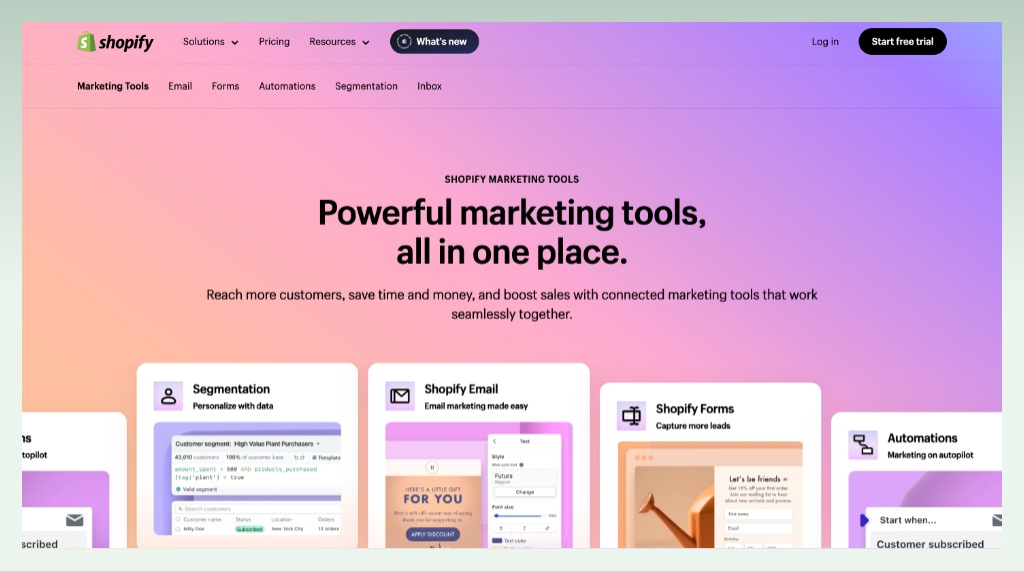
Amazon, while powerful for product visibility and sales within its ecosystem, provides more limited options for direct marketing and brand building.

Our verdict: Shopify wins and suits sellers who prioritize comprehensive marketing strategies, including email marketing, content creation, and SEO optimization.
💡 Learn more: Shopify vs WordPress: Which is Better for Your eCommerce Store?
2.6. App & integrations
| Apps and Integrations | Shopify | Amazon |
| Number of Apps | Extensive marketplace with over 8,000 apps on the Shopify App Store. | 3386 apps from third parties with the approval of Amazon. |
| Categories and Variety | – Store design – Finding products – Selling products – Marketing and conversion – Orders and shipping – Store management | – Product listing – Customer engagement – Inventory and shipping – Finances – Marketing – eCommerce management |
| App Installation Process | Generally straightforward, with one-click installations for most apps. | Installation and integration can vary, sometimes requiring more technical setup. |
Shopify owns an extensive app marketplace, combined with a user-friendly navigation and installation process, which makes it easier for merchants to find and utilize tools that can grow their business.
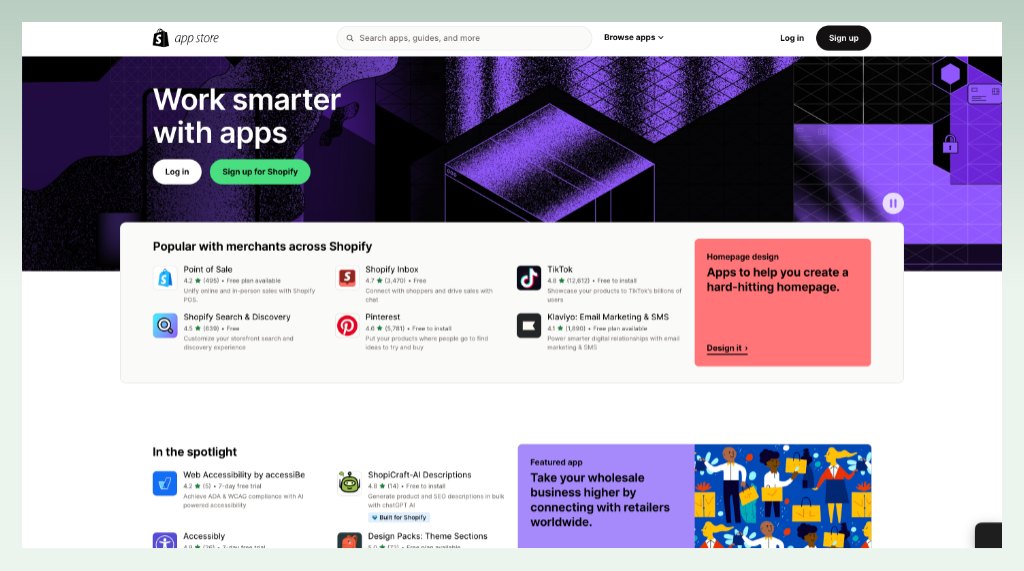
Amazon provides third-party software tools that are approved by Amazon to help you automate, manage, and grow your business.
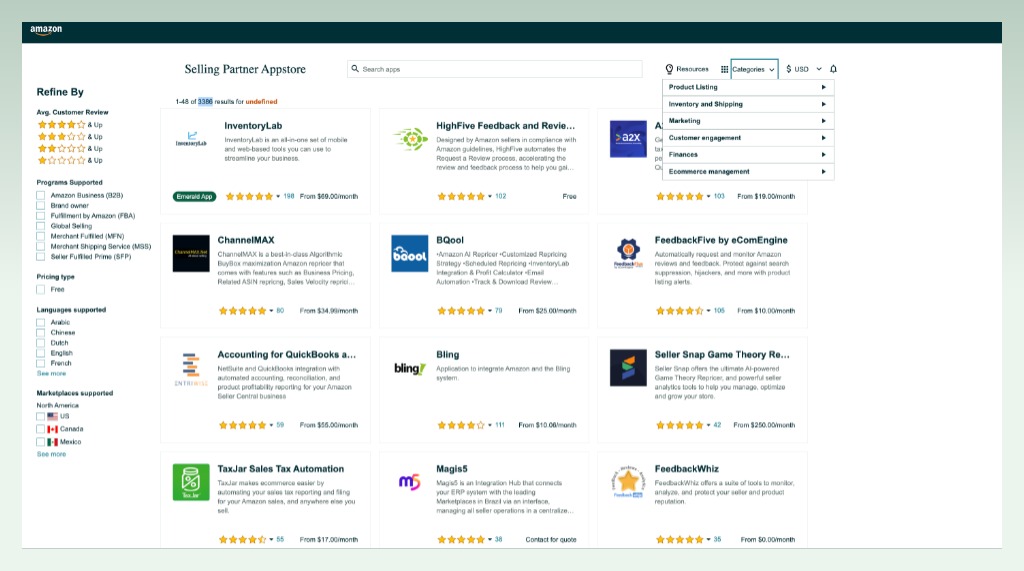
Our verdict: Shopify wins as it has a broader and more diverse range of apps to enhance and customize the eCommerce experience.
2.7. Scalability
| Criteria | Shopify | Amazon |
| Infrastructure Scalability | – Scales with your business – Supports growth without requiring manual upgrades. | Supports sellers of any size with unparalleled reliability. |
| Global Reach | Enables sellers to expand internationally with multi-currency support and international domains. | – Vast global presence across the world – Easier to reach international customers. |
| Customer Base Expansion | Tools and integrations for SEO, social media, and multi-channel selling help attract new customers. | Access to a massive, established customer base, with opportunities to tap into Amazon’s loyal shoppers. |
| Support for High-Volume Sales | Plans and features designed to support businesses as they grow, including advanced analytics and reporting. | Exceptional handling of high-volume sales through efficient fulfillment options like FBA and customer service. |
| Flexibility and Customization | High degree of flexibility in store design, functionality, and third-party integrations, supporting unique business models. | Limited customization in terms of storefront design, but offers strong backend scalability for product listings and order handling. |
| Ease of International Expansion | Tools and guidance for international selling, but may require additional setup for localization and compliance. | Seamless integration into existing international marketplaces, with straightforward processes for expanding globally. |
Amazon has a built-in audience, fulfillment services, and streamlined processes for international expansion, offering unparalleled advantages for scaling quickly. Shopify, while offering robust tools and flexibility for brand building and customization, requires more effort from merchants to scale internationally and attract a customer base.
For businesses prioritizing rapid scale and global reach with minimal logistical concerns, Amazon presents a more straightforward path.
Our verdict: Amazon wins in terms of scalability for sellers aiming to leverage an established infrastructure and immediate access to a global customer base.
3. Shopify vs Amazon: Who Holds the Winning Hand?

3.1. Pros and Cons of Shopify
Pros:
- User-friendly: Shopify’s intuitive design simplifies online store management.
- Highly customizable: Offers extensive themes and customization options.
- Rich app marketplace: Features over 8,000 apps for enhanced functionality.
- Built-In SEO: Provides SEO and marketing tools to enhance your online visibility.
- Multi-channel selling: Allows to sell across different platforms and marketplaces.
Cons:
- Costs can add up: Monthly and transaction fees, plus paid apps, may get expensive.
- Learning curve for customization: Customizing and using apps effectively requires time.
- Limited CMS features: Offers basic blogging but lacks advanced content management capabilities.
Choose Shopify if you:
- Prefer an easy-to-use platform for managing your online store.
- Want a customizable and standout online presence
- Need a scalable solution for business growth.
- Seek a wide array of functional extensions through apps.
- Aim to sell through multiple channels.
- Value accessible, round-the-clock support.
3.2. Pros and Cons of Amazon
Pros:
- Massive audience: Instant access to a global customer base.
- Fulfillment services: Leverages Amazon’s fulfillment for easy shipping.
- Trust factor: Benefits from Amazon’s high level of customer trust.
- Prime eligibility: Increases sales potential through Prime membership perks.
- Simple setup: Quick product listing and sales start the process.
Cons:
- High competition: Crowded marketplace with intense competition.
- Fees can be high: Listing, selling, and FBA fees may reduce margins.
- Limited branding: Fewer opportunities for custom branding and customer relationship building.
- Strict policies: Must adhere to Amazon’s stringent seller policies and rules.
Choose Amazon if you:
- Aim to reach a vast, global audience quickly.
- Prefer to use established fulfillment networks for shipping.
- Wish to capitalize on Amazon’s customer trust and Prime perks.
- Can navigate a competitive marketplace to stand out.
- Accept the trade-off of higher fees for broader market access.
- Are willing to work within strict platform policies for the chance at high volume sales.
3.3. Our verdict

Is Shopify better than Amazon, the final decision depends on your business needs and goals.
Choose Shopify if you prioritize branding, customization, and building direct customer relationships. This platform is ideal for those looking to grow and scale their business with a personalized online store, leveraging extensive marketing tools and support.
Opt for Amazon to access a vast customer base and leverage a robust logistics network quickly. It suits sellers focused on immediate sales in a competitive marketplace, despite higher fees and strict platform rules.
Final Verdict: Shopify is for brand-centric sellers seeking control and growth, while Amazon suits those prioritizing market reach and convenience.
>>> Looking for more eCommerce options like Amazon? Check out detailed comparisons between Shopify vs competitors. You’ll find a variety of platforms, each with its own advantages and disadvantages. Choose the one that fits your online store’s goals best.
4. Shopify and Amazon: Can we use them together?
In fact, you can use Shopify and Amazon together to maximize your success. Many businesses do so to leverage the strengths of both platforms. Integrating Shopify with Amazon is the ultimate way to mix Shopify’s powerful eCommerce tools and customization capabilities with Amazon’s huge customer base and fulfillment network.
Here’s the benefits of combining selling on Shopify vs Amazon:
- Expand reach: Utilize Amazon for its vast audience and Shopify for a unique online store experience.
- Channel diversity: Mix Shopify and Amazon to reduce reliance on one market and enhance stability.
- FBA benefits: Apply Amazon’s FBA for Shopify orders for streamlined shipping and fulfillment.
- Unified inventory: Simplify inventory control across both platforms using Shopify’s dashboard.
- Double strengths: Combine Amazon’s enormous reach with Shopify’s branding and marketing power.
5. Conclusion
In concluding the Shopify vs Amazon comparison from eComStart, both platforms cater to different needs. Shopify excels in customization and brand building, ideal for those wanting control over their online presence. Meanwhile, Amazon offers vast market access and easy fulfillment, perfect for quick sales and broad reach.
Choosing between Shopify vs Amazon store depends on your business goals. If you want to build a unique brand and customer experience, go for Shopify. If you are looking for a large audience with less hassle, Amazon is your best choice. And of course, you can use both to maximize their strengths, Shopify for branding and Amazon for reach, just like many businesses successfully did.
Thinking about your next move in e-commerce? Consider what Shopify and Amazon can do for you. Whether you choose one or both, now’s the time to expand your online business. Dive in and start growing today!


